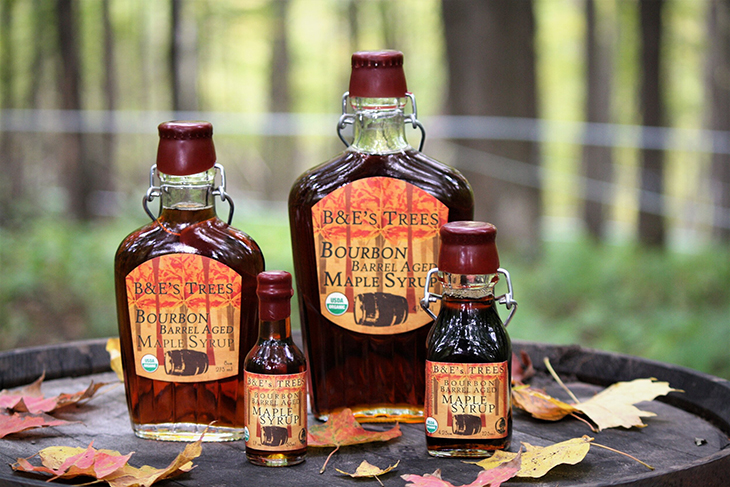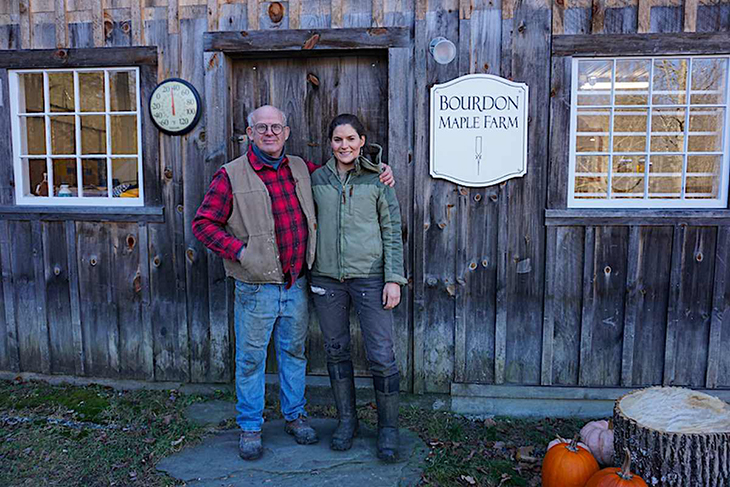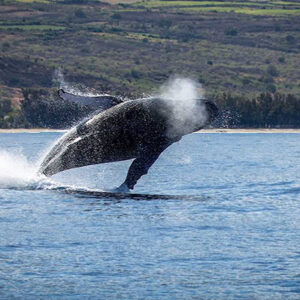
As dawn breaks, the enchanting melody of a wood thrush resonates through the expansive 55-hectare (135-acre) forest at Bourdon Maple Farm in Woodstock. A vibrant scarlet tanager gracefully soars through the treetops, while eager yellow-bellied sapsuckers diligently peck at tree bark.
During the peak of the maple sugaring season, the symphony of birds serves as a soothing backdrop for Meg Emmons, who oversees operations, sales, and marketing at the farm.
“A lot of times, the birds are my only company out here in the woods,” she said, as she happily gazed at a nearby black-capped chickadee. The forest’s most vocal residents, however, are also some of its most affected.
Forest birds flourish in a variety of environments characterized by the presence of young, middle-aged, and old-growth trees. However, in New England, the majority of trees are now uniformly middle-aged, a consequence of widespread clearing for agriculture in the 1800s. The ongoing pressure of modern development continues to transform woodlands into residential areas, parking lots, and other non-forested landscapes, further diminishing available habitats.
Consequently, numerous forest bird populations have already experienced a sharp decline. For example, wood thrush populations have more than halved in the last 50 years due to forest loss, which has increased nest exposure to predators and parasites. Vermont’s Wildlife Action Plan has recognized it as a high-priority “species of greatest conservation need.”

Recent advancements in technology have sparked a significant growth in the maple syrup industry over the last 15 years in the United States and Canada. However, this expansion has led to the potential neglect of other tree species within the “sugarbush,” the designated area where sugar maples are tapped.
Some maple producers adopt an “I tend to the trees I tap” mindset, prioritizing sugar maples and minimizing competition with other vegetation. Yet, the removal of too many non-maple trees jeopardizes the overall health of the forest and, consequently, the sugar maples themselves. In extreme cases, producers eliminate all non-maples growing beneath the forest canopy.
Don Bourdon, the owner of Bourdon Maple Farm, encountered a producer who routinely cleared his woods with a lawnmower, cutting down any species seemingly hindering the success of his maples. However, when sugar maples make up more than 90% of the sugarbush composition, producers essentially create a monoculture, according to experts.
While labeling a sugarbush as a monoculture may seem unusual, as the term is typically associated with industrial agriculture, such as vast fields of corn, soy, or wheat replacing diverse forests or prairies, maple industry monocultures are less common and less damaging. Sugarbushes usually maintain the integrity of the forest, which is preferable to clearing it for annual crops. Nevertheless, cultivating trees in a monoculture still restricts the forest’s ability to support wildlife and withstand ecological disturbances.
Promoting species diversity in tended fields or forests aligns with the principles of agroecology, which views agriculture as an ecosystem rather than a mere food factory. Agroecology encompasses various techniques, from organic farming to integrated pest management and agroforestry, and is recognized as a prominent climate solution by sequestering carbon, as stated by the Intergovernmental Panel on Climate Change in 2022.
As the proportion of sugar maple trees exceeds 75% in a forest, the diversity and abundance of birds decline, as observed in the case of maple monocultures. To address this issue, Audubon Vermont collaborated with the Vermont Maple Sugar Makers’ Association and the Vermont Department of Forests, Parks, and Recreation to launch the Bird-Friendly Maple Project in 2014. This initiative acknowledges producers who safeguard and enhance forest bird habitats, offering a label for customers to identify when purchasing syrup.
To earn the bird-friendly label, maple producers must commit to a management plan that ensures a sugarbush composition of no more than 75% sugar maples in the future. In addition to promoting tree species diversity, bird-friendly producers must enhance the structural complexity of their sugarbush, aiming for at least 25% vegetation coverage in the forest’s understory and midstory. Ultimately, participating farms’ sugarbushes should exhibit lush greenery in summer, providing optimal nesting and foraging opportunities from the forest floor to the canopy.
“A messy forest is a little harder to work in. As a sugar maker, it can be difficult to walk out and tap your trees if you’re working through brambles and snags — but it’s good for the wildlife,” said Aaron Wightman.
Aaron has dedicated his life to maple production and serves as the co-director of the Cornell Maple Program. In this role, he and his team of researchers delve into various initiatives for sugarbush diversification. This includes the cultivation of nutrient-rich forest products like berries and nuts beneath the forest canopy, as well as the extraction of alternative tree syrups.
“Retaining at least 25% non-maple species and creating structural diversity in a sugarbush are powerful strategies for bolstering the populations of birds and other forest species,” Wightman further told Mongabay.
Resilience is an inherent quality that accompanies diversity. A forest that caters to the needs of various bird species not only enhances wildlife support but also bolsters its resistance against threats such as pests, diseases, and extreme weather events. This resilience is attributed to the presence of a diverse array of trees and the active role played by birds, acting as efficient predators that help control insect populations, preventing damage to trees and the spread of tree diseases.
Steve Hagenbuch, a conservation biologist at Audubon Vermont, draws parallels between the diversification of a sugarbush and navigating the stock market. He likens the potential risks to investing in a single account versus a diversified portfolio, emphasizing the advantage of spreading investments to mitigate negative impacts on a specific area.
In 2020, Audubon Vermont, in collaboration with the Vermont Center for Ecostudies and the University of Vermont (UVM), initiated a study to assess how forest bird communities respond to different habitat characteristics in actively managed sugarbushes. The findings from field surveys conducted in 2020 and 2021 across 14 active sugarbushes in Vermont, with nine enrolled in the Bird-Friendly Maple Project, suggest that the current management guidelines of the program require minimal modification. The cultivation of diverse vegetation and structure in a sugarbush proves essential in meeting the varied needs of forest birds, thereby supporting increased bird diversity and abundance.
Key findings indicate that factors such as increased low woody vegetation and sapling richness significantly correlate with the abundance of specific bird species, including mourning warblers, chestnut-sided warblers, and black-throated blue warblers, which prefer nesting in saplings and shrubs. Leaf litter depth emerges as a critical habitat feature benefiting all forest birds, serving various purposes such as foraging, nest-building, and predator avoidance.
The study also sheds light on the impact of nonnative earthworms on the valuable leaf litter layer and suggests potential additions to Audubon Vermont’s bird-friendly management guidelines. These additions may include considerations for monitoring and managing earthworm presence in the sugarbush.
Ongoing research by UVM aims to expand on the study’s evaluation of bird-friendly management practices, with additional field data collected in 2022 and 2023. Liza Morse, a UVM Ph.D. candidate, actively contributed to the four years of data collection and plans to interview participating sugar makers to delve into the specifics of their management approaches and their connection to maple sugaring and sugarbush biodiversity.
“Current bird-friendly targets are based on best practices for forest management in general, but the hope is that we can drill down on the drivers of change in a sugarbush and what they mean for birds,” Morse said. “Programs like the Bird-Friendly Maple Project are only going to improve as they are evaluated by research and continue to self-reflect.”
Meg Emmons from Bourdon Maple Farm initially reached out to Hagenbuch of the Bird-Friendly Maple Project in late 2021. Spotting the project’s logo on fellow producers’ websites, she sought recognition for their 10,000-tap operation. After a comprehensive assessment in spring 2022, Hagenbuch determined that aligning with the bird-friendly ethos would complement their existing four-decade forest management plan.
Although their sugar maple-dominated forest is a work in progress, constituting about 90% of the larger trees in the sugarbush, their dedication to diversification earned them the bird-friendly designation. Acknowledging the slow pace of change in “forest time,” they thin sugar maple density, combat invasive plants, and preserve dead trees to support hole-nesting birds like woodpeckers. Their commitment extends to avoiding disruptive practices during the birds’ nesting season, from May to mid-July.
Walking through the sugarbush, Emmons observed a fallen tree branch on tapping equipment, promptly declaring, “We’ll leave that for the birds.”
Mr. Bourdon is among the 90 Vermont maple producers embracing the Bird-Friendly Maple Project, now expanding to New York, Massachusetts, and Maine. The program has influenced approximately 7,284 hectares (18,000 acres) of bird-centric forest management across participating sugarbushes.
The benefits extend beyond birds, as producers can showcase their commitment through the program’s scarlet tanager logo. This emblem, representing a species benefiting from the effort, serves as a visual marker for sustainable maple operations. Bird-friendly producers leverage the logo to attract customers and business opportunities, aligning with the growing interest in local, sustainable food products.
For Bourdon and Emmons, the label presents an exciting avenue to educate customers about conservation in maple production. During sugarbush tours, they distribute a maple bingo game encouraging participants to observe and listen for birds. Emmons has encountered birders thrilled to discover that maple syrup producers like them actively contribute to supporting wild bird populations.
“People really value it,” said Emmons. “They’re supporting environmentally friendly products and causes through socially conscious shopping.”
Bourdon encapsulated the importance and essential nature of extracting resources from thriving forest ecosystems with a concise expression.
“Although boiling happens in the sugarhouse, maple syrup is really made in the woods.”
What are your thoughts? Please comment below and share this news!
True Activist / Report a typo


